|
 Bertrandia astatogala Bertrandia astatogala
SynonymsHygrocybe astatogala
Bertrandia astatogala
BiostatusPresent in region - Indigenous. Non endemic
Images (click to enlarge)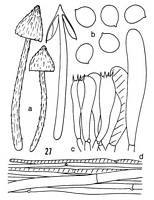
Caption: Fig. 27: Bertrandia astatogala Heim: a. carpophores. - b. spores. - c. basidia. - d. cuticle (Herb. HK. ZT 68/553) | 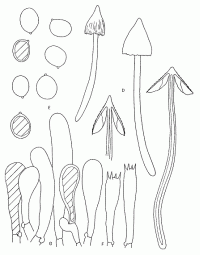
Caption: Fig. 51 Bertrandia astatogala Heim ex Heim (D-G: ZT 68/553):
D. basidiomes. E. spores. F. basidia. G. cheilocystidia | 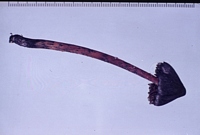
Owner: Herb. PDD | 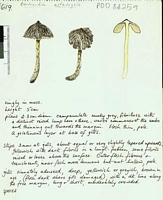
Caption: Watercolour
Owner: G.M. Taylor | 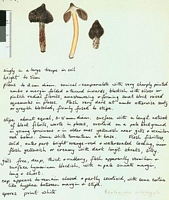
Caption: Watercolour
Owner: G.M. Taylor | 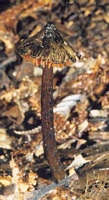
Owner: Kaimai Bush | 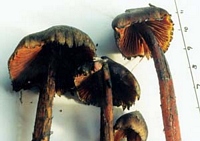
Owner: Kaimai Bush | 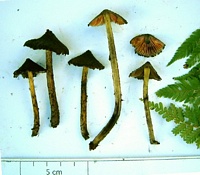
Owner: Karl Soop | 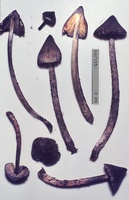
Caption: ZT68-553
Owner: E. Horak: © Creative Commons Attribution-Noncommercial 3.0 New Zealand |
Article: Horak, E. (1990). Monograph of the New Zealand Hygrophoraceae (Agaricales). New Zealand Journal of Botany 28(3): 255-306 (http://www.rsnz.org/publish/abstracts.php).
Description: Pileus -35 mm, distinctly and persistently conical p (apex always pointed)
becoming conico-convex or conico-campanulate, radially splitting at margin;
yellowish to orange at first soon turning black when bruised or in aged specimens;
dry, densely covered . with black hairy fibrils, not hygrophanous, margin non-striate.
-Lamellae distant to crowded, adnexed to almost free, ventricose, not reaching
margin of pileus; brilliant orange turning to grey-yellow and finally black,
crenate edges concolorous or paler. -Stipe 60-130 x 3-6 mm, cylindrical, equal
or gradually attenuated towards apex, slender; yellowish to pale orange turning
black with age, densely covered, with black hairy scales and fibrils; dry, fistulose,
brittle, single. - Context yellow turning black on exposure, brittle. - Odour
and taste not distinctive. -Chemical reactions on pileus: KOH and HCI - negative.
Spores 7-9.5 x 6-8.5 um, subglobose to ovoid, hyaline when freshly shed in
spore print but becoming dark brown due to pigment dissolved in plasma. –Basidia
30-45 x 8-11um, 4-spored. -Cheilocystidia 35-90 x 10-30 um, clavate to vesiculose,
with yellow or black (in aged specimens) plasmatic pigment. - Pileipellis a
cutis or trichoderm of repent, to ascending, cylindrical hyphae (4-20 um diam.),
membrane not gelatinised, oleiferous hyphae numerous in subcutis; clamp connections
present (Pl. 1, Fig. 4).
Habitat: ECOLOGY: Scattered; saprobic on soil among litter in broadleaved-conifer forest
(Leptospermum, Beilschmiedia, Weinmannia, Dacrydium, Cyathea). June.
Distribution: DISTRIBUTION: NZ (NA, T). - Madagascar, Central Africa, Philippines.
Article: Horak, E. (1973). Fungi Agaricini Novazelandiae I-V. Beihefte zur Nova Hedwigia 43: 200 p.
Description: Pileus 13-35 mm diam., obtusely to sharply conic when young, becoming conico-campanulate, radially splitting, yellowish to orange when young, quickly becoming black when bruised or in aging, densely covered with black, hairy fibrils, dry, estriate. Lamellae nearly free to adnexed, deep orange when young turning grey-yellow and finally black, gill-edge concolorous, eroded, not reaching margin of pileus. Stipe 60-130 x 3-6 mm, cylindric, equal, occasionally attenuated towards the apex, strict, brittle, fistulose, yellowish to light orange, becoming black like pileus, densely covered with hairy to scaly black fibrils, dry, single. Context yellow turning black. Taste and odor not distinctive. Chemical reactions on pileus: HCl, KOH and NH3 - negative.
Spores 7-9.5 x 6-8.5 µm, subglobose to ovoid, smooth, inamyloid. Basidia 42-45 x 10-11 µm, 4-spored. Cheilocystidia absent, but gill edge formed by clavate cells (40-90 x 10-15 µ) with yellow or (on old carpophores) black, plasmatic pigment. Cuticle a cutis consisting of repent, long cylindric, not gelatinized hyphae, grey-lilac plasmatic pigment present, lactiferous hyphae numerous. Clamp connections on septae.
Habitat: On soil amongst litter of Beilschmiedia, Weinmannia and Cyathea. New Zealand, Madagascar, Congo, Cameroon, Philippines.
Notes: The lectotype of this striking species, originally collected in Madagascar, was studied (Horak 1968: 118) and compared with the N.Z. material. No apparent differences were found. According to our present knowledge B. astatogala Heim occurs in the tropical-subtropical belt of Africa (Cameroon, Congo, Madagascar) and SE-Asia (Philippines, New Zealand).
|